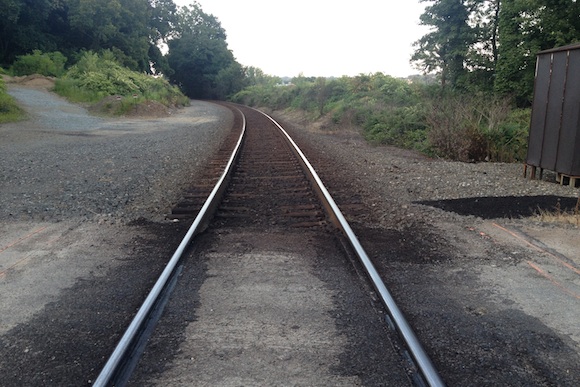A couple of weeks ago, Keystone Edge rain a feature on train travel in Pennsylvania, detailing the complex challenge of improving efficiency and ridership. Yesterday, we received a thoughtful response from Mark Spada, a board member at Western Pennsylvanians for Passenger Rail that we felt added to the conversation. Read on to discover some interesting facts about ridership on Amtrak's Pennsylvanian line and what passionate organizations are doing to boost regional train travel even further.
Thank you for writing the article about Pennsylvania passenger rail travel that appeared in Keystone Edge on September 11. The story makes your readers aware Pittsburgh does have passenger trains that are a viable option for travelers to consider.
As the story noted, Pennsylvania's investment in the Harrisburg – Philadelphia Keystone line, in terms of both infrastructure improvements and more frequent service, has resulted in a very successful operation that should see approximately 1.5 million riders in Fiscal Year 2014 (October 2013 – September 2014). This same model is directly applicable to improving service along the Pittsburgh – Harrisburg – Philadelphia – New York route, now served once per day by Amtrak's Pennsylvanian. Information about the present operation of the train suggests the state would replicate the Keystone line's success in Western and Central Pennsylvania through similar investments in the Pennsylvanian.
For example, despite sharing the Harrisburg – Pittsburgh portion of its route with freight trains, the Pennsylvanian has achieved the second highest on-time performance of all routes in the Amtrak system during the first ten months of Fiscal Year 2014 (FY14). At 91.0 percent through July, the Pennsylvanian's figure exceeded that of the Keystone line (82.6 percent), the high-speed Acela service (75.3 percent) and regional service on the Northeast Corridor (75.7 percent).
Further, not only is the Pennsylvanian a highly reliable train, it is also a heavily used one. The Keystone line, rightly hailed by the state and passenger rail observers alike as a great success, currently operates at about 43 percent capacity (percentage of available seat-miles that are filled by passengers). The Pennsylvanian currently operates at 63 percent. This number again places it among the highest percentages of any of Amtrak's routes. The popularity of the train has resulted in it having a ridership increase of 6.3 percent through July in FY14 over the same period in 2013 (third highest on the Amtrak system) and the highest percentage increase in revenue of any route over the same period (11.2 percent). This compares to the Keystone figures of 2.3 percent and 7.2 percent for ridership and revenue, respectively. Based on numbers reported through July, an estimated 230,000 riders will ride the Pennsylvanian in FY14. If the Keystone line is considered to be a success, so, too, should the Pennsylvanian.
Additionally, the article may have implied that the train is used primarily by travelers to or from Pittsburgh. In reality, approximately 40 percent of the Pennsylvanian's riders are from the stations between Pittsburgh and Harrisburg – Greensburg, Latrobe, Johnstown, Altoona, Tyrone, Huntingdon and Lewistown. For these towns, there are very few, if any, other transportation choices besides the train.
Pittsburgh, despite its larger area population, also suffers from the same issue. There is no air service between Pittsburgh and Harrisburg. Even Megabus, which does not service any of the aforementioned intermediate towns, has become a less viable option for Pittsburgh travelers. Not only did they recently reduced the number of daily Pittsburgh – Harrisburg trips from three to two (this after ending all service west of Pittsburgh in early May), Megabus also added a stop in State College to the trip, considerably lengthening travel time between Pittsburgh and Harrisburg.
As noted by some of those quoted in the article, the present service of one daily train between Pittsburgh, Harrisburg and beyond to Philadelphia and New York limits the convenience for potential passengers, despite the Pennsylvanian's excellent on-time and ridership figures, throughout Western and Central Pennsylvania. A major reason for the Keystone line's success is the high frequency of service at 13 daily weekday trains.
A PennDOT spokesperson said ridership has increased significantly since trains were added to the Keystone line. That is why our organization, Western Pennsylvanians for Passenger Rail (WPPR), is advocating the expansion of service on the Pennsylvanian' route. A report titled On Track to Accessibility, a collaborative effort between WPPR and Pittsburgh Downtown Partnership and posted on WPPR's website discusses the potential costs and benefits of increasing service from one to three daily trains.
As illustrated by the Keystone line, more trains, thus more convenient service, will attract more riders. In fact, the study mentioned in the article that reviews the options for service improvements along the Pennsylvanian's route (Keystone West Corridor Study) was recently released to PennDOT after the Federal Railroad Administration finished its review in August. According to PennDOT, the study will be posted on their Keystone West website by October 3.
WPPR believes that an increase in service, infrastructure improvements, and additional initiatives by the state, such as including Western Pennsylvania destinations among the PA Trips By Train excursions, will result in the Pennsylvanian route emulating the success of the Keystone line. Please visit WPPR's website for more information about these and other issues regarding Pennsylvania passenger rail service.
Mark Spada
Board Member
Western Pennsylvanians for Passenger Rail
